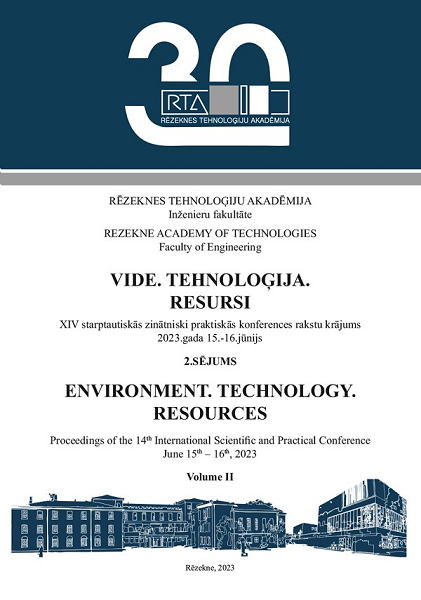BASIC PRINCIPLES OF USING VIRTUAL AND AUGMENTED REALITY TECHNOLOGIES IN THE PROCESS OF TEACHER TRAINING IN UKRAINE
DOI:
https://doi.org/10.17770/etr2023vol2.7268Keywords:
AltspaceVR, augmented reality, educational technology, virtual reality, teacher trainingAbstract
In our opinion, in all aspects, education should correspond to the modern realities of the world, for life and communication with which we prepare a person. We propose to pay attention to the preparation of the individual, because without the readiness of the teacher to fulfil his or her responsibilities for socialization and development of skills necessary for self-realization, we lose not only a favourable period. We lose time and opportunities for a person's success in life.
For example, teachers' lack of skills or knowledge of currently popular audio-visual content programs, building effective communication in social networks, and their quality use in the educational process create a «generation gap». After all, «gaps» in the knowledge, skills, and capabilities of a teacher or professor are immediately «striking» to children and young people, causing them to reject the teacher's personality and, as a result, the information they broadcast.
In addition, a modern young person, fascinated by the possibilities of gadgets and gamification in education, constantly needs new impressions, sensations that will allow them to engage in the educational process, and will interest young people who are oversaturated with various types of information. That is why, in this review, we outlined the main points of our use of currently available virtual and augmented reality technologies, in particular the AltspaceVR program, in the practice of training primary school teachers. We also presented our experience and various aspects of using these technologies in the Ukrainian educational space.
Downloads
References
Cabinet of Ministers of Ukraine: Pro skhvalennia Kontseptsii rozvytku tsyfrovoi ekonomiky ta suspilstva Ukrainy na 2018-2020 roky ta zatverdzhennia planu zakhodiv shchodo yii realizatsii (On approval of the Concept of the development of the digital economy and society of Ukraine for 2018-2020). https://zakon.rada.gov.ua/laws/show/67- 2018-%D1%80 . 2018.
A. V. Iatsyshyn, V. O. Kovach, V. O. Lyubchak, Y. O. Zuban, A. G. Piven, O. M. Sokolyuk, ... & M. P. Shyshkina. Application of augmented reality technologies for education projects preparation. In CTE Workshop Proceedings (Vol. 7, pp. 134-160). 2020.
C. Conn, J. Lanier, M. Minsky, S. Fisher, & A. Druin. Virtual environments and interactivity: Windows to the future. ACM Siggraph Computer Graphics, 23(5), 7–18. 1989.
Ekosystema onlayn-navchannya Sumsʹkoho derzhavnoho universytetu (Sumy State University Online Learning Ecosystem). Rozrobka na konkurs XI Mizhnarodnoyi vystavky “Innovatyka v suchasniy osviti – 2019”. Sumy State University, Sumy. 2019.
A. V. Iatsyshyn, V. O. Kovach, Y. O. Romanenko, I. I. Deinega, A. V. Iatsyshyn, O. O. Popov, ... & S. H. Lytvynova. Application of augmented reality technologies for preparation of specialists of new technological era. 2020.
History of virtual reality. Virtual Reality Society. Retrieved October 2, 2022, from https://www.vrs.org.uk/virtual-reality/history.html. 2020.
D. Boglou, K. Jauregi-Ondarra, & M. Christoforou. A Road Map for Language Teachers on How to Extract Accurate Data for Research From Inside a Quest 2 Virtual Reality Environment: The Case of The Social VR Application Altspacevr. 2022.
O.Yu. Chubukova, I.V. Ponomarenko. Innovatsiini tekhnolohii dopovnenoi realnosti dlia vykladannia dystsyplin u vyshchykh navchalnykh zakladakh Ukrainy (Augmented reality technology use for study of disciplines in ukraine’s higher education institutions). Problemy innovatsiino-investytsiinoho rozvytku 16, 20–27. 2018.
P. Milgram & A. F. Kishino. A taxonomy of mixed reality visual displays. IEICE Transactions on Information and Systems, E77-D(12), 1321–1329. 1994.
C. M. Chen & Y. N. Tsai. Interactive augmented reality system for enhancing library instruction in elementary schools. Computers & Education, 59(2), 638–652. 2012.
O. B.Petrovych. The usage of augmented reality technologies in professional training of future teachers of Ukrainian language and literature [Electronic resource] / Olha B. Petrovych, Alla P. Vinnichuk, Viktor P. Krupka, Iryna A. Zelenenka, Andrei V. Voznyak // Proceedings of the 4th International Workshop on Augmented Reality in Education (AREdu 2021). Kryvyi Rih, Ukraine. May 11, 2021 / Edited by : Svitlana H. Lytvynova, Serhiy O. Semerikov // CEUR Workshop Proceedings. Vol. 2898. P. 315-333. Access mode : http://ceur-ws.org/Vol-2898/paper17.pdf. 2021.
Zhurnalistyka zanurennia. Yak virtualna realnist staie chastynoiu pro- fesiinoi osvity. URL: https://www.jta.com.ua/trends/vr-journalism-education/. 2023
S. Martos, S. Klymovych & O. Karabuta. AltspaceVR in Distance Education of Philology Students. Publishing House “Baltija Publishing”. 2021.
T. Uskali, M. Rautiainen, M. Juntunen, R. Tallavaara & M. Hiljanen. How to Use Social VR in Higher Education: Case Study of the JYUXR Campus in Finland. In Understanding Virtual Reality (pp. 99-111). Routledge. 2022.
D. R. Vuta. Augmented reality technologies in education-a literature review. Bulletin of the Transilvania University of Brasov. Series V: Economic Sciences, 35-46. 2020.
Mentorska prohrama 3.0. [Mentoring program 3.0]. Access mode : https://youtu.be/uVWNK5VGJqY . 2021.
O. M. Sypchenko. Vykorystannia sotsialnoi platformy virtualnoi realnosti ALTSPACE VR v osvitnomu protsesi ZVO. Rekomendovano do druku vchenoiu radoiu DVNZ «Donbaskyi derzhavnyi pedahohichnyi universytet»(protokol № 8 vid 27.05. 2021 r.), 173. 2021.


